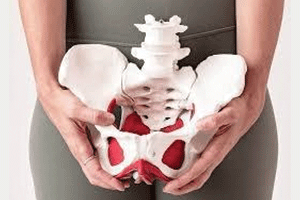
The pelvic floor defined:
Everyone has a pelvic floor. The term refers to all the soft tissues (muscles, ligaments, fascia, nerves) that lie across the bottom of the pelvis between the coccyx (tailbone) and the pubic bone in both women and men. The picture above shows someone holding a model of the entire pelvis in front of where our actual pelvis is located; the red areas represent the pelvic floor muscles. As you can see, they literally form the floor of the pelvis.
The roles of the pelvic floor:
The pelvic floor performs many critical functions:
- anatomically, it acts as a hammock-like support for the bladder, rectum, intestines, uterus (women) and prostate (men), keeping them in place
- it helps to maintain bladder and bowel control
- it helps to stabilize the pelvis and lower back
- many of our biggest muscle groups, (quadriceps – front of thigh, hamstrings – back of thigh, hip flexors – front of hip, glutes – back and sides of hip, low back, and abdominal muscles), all have attachments into the pelvis; when any of these muscles are tight or weak, they can negatively affect the pelvic floor
- it is integral to sexual function
Sometimes things go wrong:
Naturally, we tend to take things for granted until something goes wrong, and in the case of the pelvic floor, many people don’t even know that it exists. Simply put, pelvic floor dysfunction, refers to any muscular issue that causes the pelvic floor to not work properly.
These problems can often be remedied, but many people do not seek help because of embarrassment or because of the assumption that what they’re experiencing is an inevitable part of getting older. Some folks cope with urinary incontinence by limiting their fluid intake or modifying their wardrobe to hide accidents. Many use pads or other protective garments to guard against leakage, and the regular use of these products can cost hundreds of dollars a year.
Common symptoms of pelvic floor dysfunction:
- leaking urine when coughing, sneezing, laughing, or running (stress incontinence)
- failing to reach the toilet in time (urinary urgency and frequency)
- pelvic organ prolapse (when 1 or more organs in the pelvis slip down from their normal position and bulge into the vagina)
- pelvic pain
- recurrent urinary tract infections
- constipation and other problems with bowel function
- orthopedic pain in the low back, hips, groin, or coccyx
- painful intercourse
Possible causes of pelvic floor muscle dysfunction
- pregnancy
- vaginal childbirth, which may overstretch the muscles
- excess pressure on the pelvic floor caused by obesity
- chronic constipation/straining
- constant coughing
- some forms of surgery that require cutting the muscles (including prostate cancer treatment)
- lower levels of estrogen after menopause
- a fall or injury to the coccyx, (even many years ago), because all the muscles of the pelvic floor connect – either directly or indirectly – to the coccyx
So now what?
First, let me be blunt and say that doing nothing should not be an option. These things don’t get better all by themselves, and it’s very possible that you can do something right now to improve the situation. Below, I describe the commonly prescribed Kegel exercise, but I strongly encourage anyone with concerns to seek professional help.
What is a Kegel exercise?
The muscles of the pelvic floor can deliberately be clenched or relaxed. The act of intentionally squeezing the pelvic floor muscles, as when you hold back urine, is called a “Kegel”.
To do this, lift and slowly squeeze your pelvic floor muscles as if you are trying to stop the flow of urine. Try to relax your abdominal muscles, and don’t hold your breath. Make sure you release fully each time. When you know you can lift and let go, then try to hold the contraction for a few seconds. Release slowly.
It is very important to feel a full release of the muscles. A helpful image that is sometimes suggested is to imagine the release as being like ripples in a pond – the muscles release and open.
If indeed performing Kegel exercises is the right thing to do, it may take a while before you notice improvement, but things should change for the better within 4 to 5 weeks. But if they don’t, the next step is to seek help from a pelvic health physical therapist. These are physical therapists who have had extra training in treating pelvic floor problems.
To Kegel or not to Kegel
Assuming that this exercise is the ‘be all and end all’ of improving pelvic floor dysfunction runs the risk of not only oversimplifying things, but also possibly making matters worse. After all, what you may need is the anti-Kegel! The only way to know how to effectively treat this problem is to seek the advice of a physical therapy specialist.
What is pelvic floor physical therapy?
- you will first be assessed with a comprehensive evaluation
- the therapist will ask questions about your medical history, symptoms, and concerns
- the examination may include external and internal assessments of the pelvic floor muscles and surrounding areas, (the hips, your back), to assess strength, flexibility, and coordination
- treatment interventions may include specific exercises, manual techniques, and possibly biofeedback which aim to improve pelvic organ support, enhance bladder and bowel control, and alleviate pelvic pain
You can further improve the strength of your pelvic floor by:
- losing excess body weight
- preventing constipation by including more fruit, vegetables, fiber and water in your daily diet
- seeking medical attention for a chronic cough

